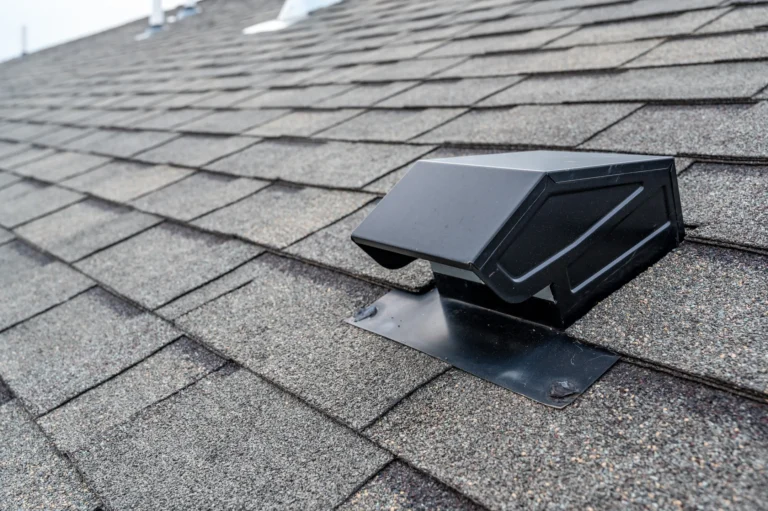
Blog
Roof Damage: How to Spot It & What To Do
When it comes to knowing the various types of roof damage, homeowners can easily get overwhelmed. How do you tell what warrants an immediate roof repair and what isn’t actually that big of a deal?
Here, we discuss four of the more common signs of roof damage, what they mean, and what you should do in response.
1. Damaged Shingles

Asphalt shingles, both architectural and 3-tab, can incur various kinds of damage:
- They can go missing.
- They can become dented or torn.
- They can develop curling edges.
While several of these issues are potential indicators that your shingles were improperly installed or that there was an error at some point during the manufacturing process, it’s more likely that these are signs of normal wear and tear.
High winds, rain, and hail can contribute to all the problems listed above. (If you haven’t had a major storm and notice newer shingles curling, though, it can be a sign that your roof doesn’t have enough ventilation.)
Even though these are some of the most common types of damage that homeowners notice, that doesn’t mean they aren’t a big deal. Left unchecked, all these concerns can lead to roof leaks that damage insulation, soak your roof underlayment, and damage your ceilings and walls.
Don’t ignore shingle granule loss, either. If you notice these granules around your foundation or washing down your gutters, get your roof checked out ASAP. These granules protect your shingles from UV damage and provide essential waterproofing, so it’s imperative you get them repaired right away to prevent water damage in the future.
2. Flashing Damage
When you get a roof replacement, your roofing contractor will install roof flashing anywhere there’s a seam in your roof. This includes anywhere your roof meets a wall, another edge of your roof, or features like vents or chimneys. This flashing, usually made out of some form of metal, directs water away from these seams and toward your gutter system.
As your roof ages, the seal on your flashing may become less effective, leaving gaps between your roofing materials and the flashing. The next time a thunderstorm rolls into your area, it’ll be leak city inside your roof.
Roof flashing may also rust over time or get irreparable dents caused by hail damage.
It’s best to leave this kind of roof repair to the professionals, as improper installation of roof flashing can leave your roof vulnerable to damage. If your insurance company discovers that you attempted repairs on your own, it may affect your insurance claim.
3. Moisture Damage

Early on, you may find algae, mold, and mildew growth on the surface of your roof. While you might wash these pesky plants and fungi away and think that’s good enough, think again. It’s in your best interest to continue to monitor your roof for other signs of water damage.
These can come in the form of dark spots or ponding water on your roof. The latter is especially a point of concern if you have a low-slope or flat roof, as it can be difficult for these kinds of roofs to drain properly. In these situations, roof repairs need to happen right away to prevent the progression of damage to your roof.
If the water damage is left to such a point where your roof begins to sag, it unfortunately means that the structural integrity of your roof has been compromised. Repairs may no longer be enough, and you’ll likely need to plan for a roof replacement instead.
If you have a metal roof, also be on the lookout for signs of rust and corrosion. This is quite common on metal roofs in coastal areas, so your contractor should be well-versed in repairing rust damage.
4. Cracked and Broken Tiles
Clay tiles are a popular roofing material choice for Florida homes because they look great, hold up well against humidity, and tend to last forever. However, they are susceptible to impact damage, and most tile roofs will sustain at least a few cracks in their lifetimes.
Luckily, this type of damage is easy to spot, and it only happens after impacts, such as hail or fallen trees from recent storms. Cracked tiles should be replaced as soon as possible.
Your Local Roofing Company for All Types of Roof Damage
As you can see, a damaged roof is more common than you think and usually isn’t a cause for panic. Now that you know the most common types of roof damage, you’ll know how to spot concerns and connect with your professional roofer before the vulnerabilities can lead to more serious damage.
For necessary repairs, you need someone you can trust to arrive on time, get the job done right, and help you save money whenever possible. Avenue Roofing is just the contractor for the job. Our customer-first approach means that we always operate with efficiency, transparency, and dependability.
Want to hear more about how we can help with your roof damage? Give us a call today!



